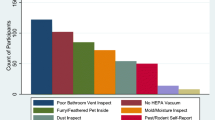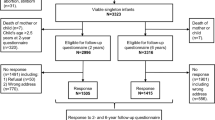Abstract
This study used results from a cross-sectional survey of parents of 3- to 5-year-old children with asthma to assess the frequency of self-reported home environmental conditions that could contribute to worsening asthma and examined the relationship between these factors and the child's asthma morbidity. Participants were 149 parents drawn from the two largest agencies that provide subsidized preschool childcare services in East and Central Harlem, inner-city communities with high prevalence of asthma. The sample represented 77% of eligibles determined by a validated case-identification instrument. Data were collected on demographics, symptoms, medication use, Emergency Department visits and hospitalization, and environmental conditions in the home. One or more of these home environmental conditions were reported by 92% of participants. Controlling for other environmental conditions and demographics, associations were found between self-reported presence of moisture or mildew on ceilings, walls, or windows and higher frequency of hospitalizations for breathing-related problems (OR = 3.31; 95% CI 1.62–6.75), frequent episodes of wheezing (OR = 3.25; 95% CI 1.8–6.0), and higher frequency of night symptoms due to asthma (OR = 2.19; 95% CI 1.4–3.41). Having a carpet or rug in the child's bedroom or the living room was also associated with hospitalizations (OR = 3.23; 95% CI 1.53–6.8), and male gender was marginally associated with the frequency of night symptoms (OR = 1.51; 95% CI .95–2.4). Asthma is prevalent in the Head Start population, and exposure to home environmental conditions that may worsen asthma is common in the socially disadvantaged populations served by Head Start programs.

Similar content being viewed by others
Abbreviations
- BRQ:
-
Brief Respiratory Questionnaire, a case identification tool used to determine inclusion
- OR:
-
Odds ratio
References
Mannino DM, Homa DM, Akinbami LJ, Moorman JE, Gwynn C, Redd SC. Surveillance for asthma—United States, 1980–1999. MMWR, Surveill Summ. 2002;51:1–13.
Stevenson L, Kaminsky M. Asthma hospitalization and mortality in New York City, 1987–1996. In: Conference Proceeding: Working Together to Combat Urban Asthma. The New York Academy of Medicine; 1998.
The Administration for Children and Families. 2002 Head Start Fact Sheet. Available at: http://www.acf.hhs.gov/programs/hsb/research/factsheets/02_hsfs.htm. Accessed October 24, 2005.
Slezak JA, Persky VW, Kviz FJ, Ramakrishnan V, Byers C. Asthma prevalence and risk factors in selected Head Start sites in Chicago. J Asthma. 1998;35:203–212.
McGill KA, Sorkness CA, Ferguson-Page C, et al. Asthma in non-inner city Head Start children. Pediatrics. 1998;102:77–83.
The Administration for Children and Families. A Descriptive Study of the Head Start Health Component. Volume II: Technical Report. Available at: http://www.acf.hhs.gov/programs/opre/hs/descriptive_stdy/reports/descrip_stdy_vol2/hshealth_vol2.pdf. Accessed October 24, 2005.
Leaderer BP, Belanger K, Triche E, et al. Dust mite, cockroach, cat, and dog allergen concentrations in homes of asthmatic children in the northeastern United States: impact of socioeconomic factors and population density. Environ Health Perspect. 2002;110:419–425.
Phipatanakul W, Eggleston PA, Wright EC, Wood RA. Mouse allergen. I. The prevalence of mouse allergen in inner-city homes. The National Cooperative Inner-City Asthma Study. J Allergy Clin Immunol. 2000;106:1070–1074.
Krieger JW, Song L, Takaro TK, Stout J. Asthma and the home environment of low-income urban children: preliminary findings from the Seattle-King County healthy homes project. J Urban Health. 2000;77:50–67.
Kitch BT, Chew G, Burge HA, et al. Socioeconomic predictors of high allergen levels in homes in the greater Boston area. Environ Health Perspect. 2000;108:301–307.
Brunekreef B, Dockery DW, Speizer FE, Ware JH, Spengler JD, Ferris BG. Home dampness and respiratory morbidity in children. Am Rev Respir Dis. 1989;140:1363–1367.
Jaakkola JJ, Jaakkola N, Ruotsalainen R. Home dampness and molds as determinants of respiratory symptoms and asthma in pre-school children. J Expo Anal Environ Epidemiol. 1993;3(suppl 1):129–142.
Ladebauche P, Nicolosi R, Reece S, Saucedo K, Volicer B, Richards T. Asthma in Head Start children: prevalence, risk factors, and health care utilization. Pediatr Nursing. 2001;27:396–399.
Hynes HP, Brugge D, Osgood ND, Snell J, Vallarino J, Spengler J. BWhere does the damp come from?^ Investigations into the indoor environment and respiratory health in Boston public housing. J Public Health Policy. 2003;24:401–426.
Diaz T, Sturm T, Matte T, et al. Medication use among children with asthma in East Harlem. Pediatrics. 2000;105:1188–1193.
Claudio L, Tulton L, Doucette J, Landrigan PJ. Socioeconomic factors and asthma hospitalization rates in New York City. J Asthma. 1999;36:343–350.
Bonner S, Matte T, Rubin M, et al. Validating a questionnaire to identify Head Start children with probable asthma. Manuscript under submission, 2005.
National Heart, Lung and Blood Institute National Asthma Education and Prevention Program. Expert Panel Report 2: Guidelines for the Diagnosis and Management of Asthma. 1997.
The Administration for Children and Families. 45 CFR Part 1304-Program Performance Standards for Operation of Head Start Programs by Grantees and Delegate Agencies. Available at:http://www.acf.hhs.gov/programs/hsb/pdf/1304_ALL.pdf. Accessed October 24, 2005.
Acknowledgement
This research was funded by a grant from the Centers for Disease Control and Prevention (U48/CCU209663 SIP21).
Author information
Authors and Affiliations
Corresponding author
Additional information
Drs. Bonner PhD, Matte and Fagan and Ms. Andreopoulus are with the Center for Urban Epidemiologic Studies (CUES) of the New York Academy of Medicine.
Rights and permissions
About this article
Cite this article
Bonner, S., Matte, T.D., Fagan, J. et al. Self-Reported Moisture or Mildew in the Homes of Head Start Children with Asthma is Associated with Greater Asthma Morbidity. JURH 83, 129–137 (2006). https://doi.org/10.1007/s11524-005-9012-7
Published:
Issue Date:
DOI: https://doi.org/10.1007/s11524-005-9012-7




